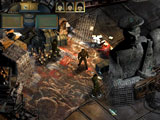 Europe
is mostly known for its great beer and great board games. (And all that
history stuff.) While Americans suffer through Coors Light and idiotic
"party games" like Pictionary and Scattergories, Europeans spend
their weekend evenings drinking Budweiser Budvar and playing way cool
games like Formula De and Tikal and The Settlers of Catan. So you gotta
wonder—why doesn’t all that talent translate to PC games? Up until
now, our European brothers haven’t produced much of anything worthwhile
for the PC—but that may change with Odium, the brainchild of Metropolis,
an ambitious Polish design group. Monolith will be publishing the game in
the States (it goes by the name of Gorky-17 in Europe), and what we’ve
seen of the beta looks awfully good.
Europe
is mostly known for its great beer and great board games. (And all that
history stuff.) While Americans suffer through Coors Light and idiotic
"party games" like Pictionary and Scattergories, Europeans spend
their weekend evenings drinking Budweiser Budvar and playing way cool
games like Formula De and Tikal and The Settlers of Catan. So you gotta
wonder—why doesn’t all that talent translate to PC games? Up until
now, our European brothers haven’t produced much of anything worthwhile
for the PC—but that may change with Odium, the brainchild of Metropolis,
an ambitious Polish design group. Monolith will be publishing the game in
the States (it goes by the name of Gorky-17 in Europe), and what we’ve
seen of the beta looks awfully good.
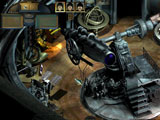 In
Odium you take the role of Cole Sullivan, commander of a small group of
elite NATO commandos. (Though, oddly enough, these supertroopers begin the
game armed only with single-shot rifles—Rainbow Six never had it so
bad). Your mission is to infiltrate an abandoned Polish city and gather
information. Sounds like a routine recon patrol, but soon enough things
begin to go very, very, wrong. It seems that the city had been the site of
some top-secret Soviet military experiments, and the monstrous results of
those experiments lurk in the ruins.
In
Odium you take the role of Cole Sullivan, commander of a small group of
elite NATO commandos. (Though, oddly enough, these supertroopers begin the
game armed only with single-shot rifles—Rainbow Six never had it so
bad). Your mission is to infiltrate an abandoned Polish city and gather
information. Sounds like a routine recon patrol, but soon enough things
begin to go very, very, wrong. It seems that the city had been the site of
some top-secret Soviet military experiments, and the monstrous results of
those experiments lurk in the ruins.
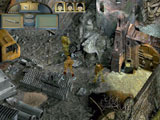 Like
the monsters you’ll hunt down, Odium is a hybrid. It reminds me a lot of
a combination of X-Com, Fallout, and the Final Fantasy series. Combat is
much like X-Com’s: it’s turn-based, and each member of your squad has
a limited number of actions per turn. Like Fallout, the game has a strong
RPG element—as you gain experience, your team members will also gain
skill points they can use to buff up their competence in a variety of
areas. The game’s also set in the gritty near future, and Odium’s maps
will remind more than one gamer of the post-apocalyptic world of Fallout.
The game’s overall form is much like Final Fantasy VII’s—you wander
through the ruins in real time until you hit a hot spot. Then the game
whisks you away to a combat interface in which your men face off against
whatever monsters inhabit the area. It may sound like a bit of a mish-mosh
in theory, but in practice the designers have implemented and synthesized
these different genres very well, so Odium plays like a combination of the
best elements of action, RPG, and adventure games.
Like
the monsters you’ll hunt down, Odium is a hybrid. It reminds me a lot of
a combination of X-Com, Fallout, and the Final Fantasy series. Combat is
much like X-Com’s: it’s turn-based, and each member of your squad has
a limited number of actions per turn. Like Fallout, the game has a strong
RPG element—as you gain experience, your team members will also gain
skill points they can use to buff up their competence in a variety of
areas. The game’s also set in the gritty near future, and Odium’s maps
will remind more than one gamer of the post-apocalyptic world of Fallout.
The game’s overall form is much like Final Fantasy VII’s—you wander
through the ruins in real time until you hit a hot spot. Then the game
whisks you away to a combat interface in which your men face off against
whatever monsters inhabit the area. It may sound like a bit of a mish-mosh
in theory, but in practice the designers have implemented and synthesized
these different genres very well, so Odium plays like a combination of the
best elements of action, RPG, and adventure games.
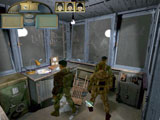 And
not only is the gameplay excellent—the game looks stunning. The
backgrounds are amazingly detailed and atmospheric 2D works of art, and
your units and the monsters they face are rendered in very sharp 3D.
Weapons effects are excellent, especially for the flame thrower and napalm
launcher. But most impressive are the mutated creatures that infest the
city. I gotta hand it to Metropolis: these monsters look fantastic, like
some demented combination of psychedelia and Hieronymus Bosch.
And
not only is the gameplay excellent—the game looks stunning. The
backgrounds are amazingly detailed and atmospheric 2D works of art, and
your units and the monsters they face are rendered in very sharp 3D.
Weapons effects are excellent, especially for the flame thrower and napalm
launcher. But most impressive are the mutated creatures that infest the
city. I gotta hand it to Metropolis: these monsters look fantastic, like
some demented combination of psychedelia and Hieronymus Bosch.
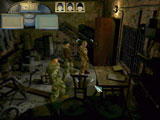 From
what we’ve played of the game, the interface is exceptionally clean and
easy-to-use. Accessing inventories, changing weapons, exchanging items
with your squadmates—all of these actions are very easily done, usually
with nothing more than a little clicking and dragging on the main screen.
The combat interface is also very clean, but also a little strange—weapon
ranges seen very stylized. For instance, ranges are extremely short, even
for rifles, and your arc of fire is limited, depending on your weapon.
Sometimes you can shoot only directly to your right, left, front, or back;
sometimes you can also shoot at the diagonal. This means that in many
cases you can’t shoot at a monster two squares away until you waste some
movement to line it up correctly. Though this adds a certain dimension to
gameplay, I’m not sure its one I want to visit.
From
what we’ve played of the game, the interface is exceptionally clean and
easy-to-use. Accessing inventories, changing weapons, exchanging items
with your squadmates—all of these actions are very easily done, usually
with nothing more than a little clicking and dragging on the main screen.
The combat interface is also very clean, but also a little strange—weapon
ranges seen very stylized. For instance, ranges are extremely short, even
for rifles, and your arc of fire is limited, depending on your weapon.
Sometimes you can shoot only directly to your right, left, front, or back;
sometimes you can also shoot at the diagonal. This means that in many
cases you can’t shoot at a monster two squares away until you waste some
movement to line it up correctly. Though this adds a certain dimension to
gameplay, I’m not sure its one I want to visit.

 Europe
is mostly known for its great beer and great board games. (And all that
history stuff.) While Americans suffer through Coors Light and idiotic
"party games" like Pictionary and Scattergories, Europeans spend
their weekend evenings drinking Budweiser Budvar and playing way cool
games like Formula De and Tikal and The Settlers of Catan. So you gotta
wonder—why doesn’t all that talent translate to PC games? Up until
now, our European brothers haven’t produced much of anything worthwhile
for the PC—but that may change with Odium, the brainchild of Metropolis,
an ambitious Polish design group. Monolith will be publishing the game in
the States (it goes by the name of Gorky-17 in Europe), and what we’ve
seen of the beta looks awfully good.
Europe
is mostly known for its great beer and great board games. (And all that
history stuff.) While Americans suffer through Coors Light and idiotic
"party games" like Pictionary and Scattergories, Europeans spend
their weekend evenings drinking Budweiser Budvar and playing way cool
games like Formula De and Tikal and The Settlers of Catan. So you gotta
wonder—why doesn’t all that talent translate to PC games? Up until
now, our European brothers haven’t produced much of anything worthwhile
for the PC—but that may change with Odium, the brainchild of Metropolis,
an ambitious Polish design group. Monolith will be publishing the game in
the States (it goes by the name of Gorky-17 in Europe), and what we’ve
seen of the beta looks awfully good.